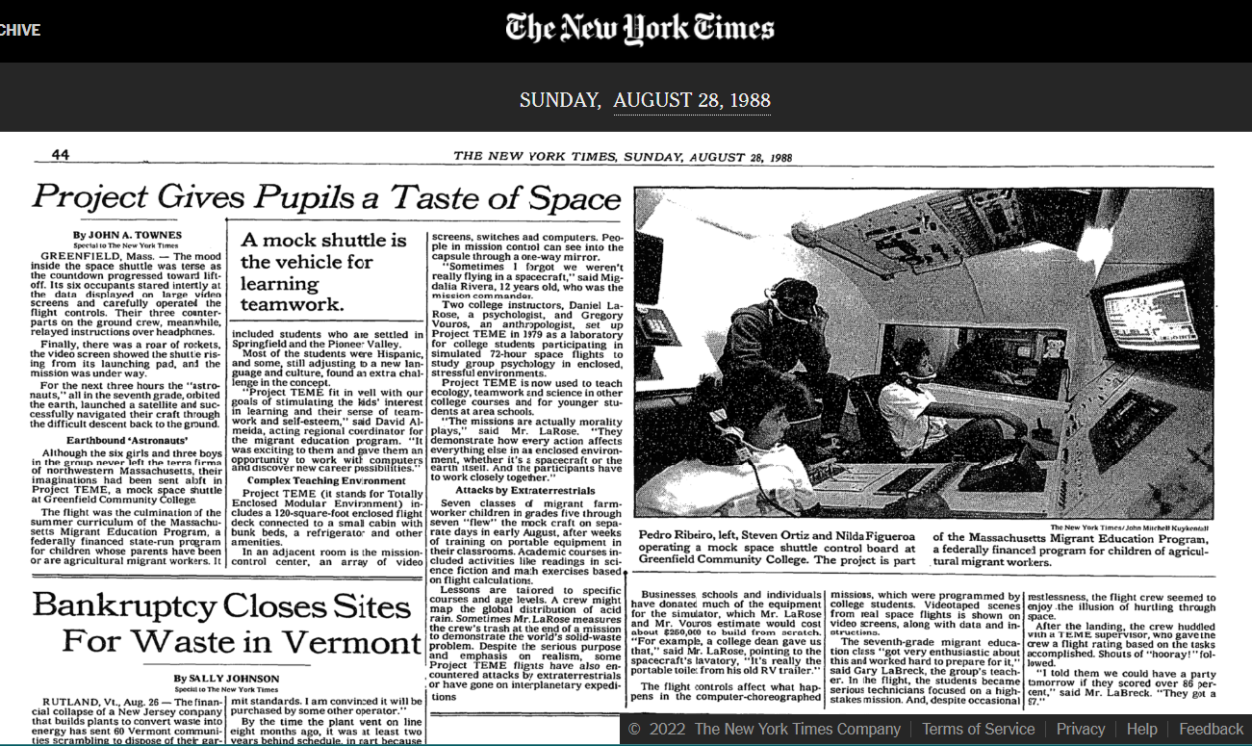By John Townes – New York Times – Aug. 28, 1988
The mood inside the space shuttle was tense as the countdown progressed toward liftoff. Its six occupants stared intently at the data displayed on large video screens and carefully operated the flight controls. Their three counterparts on the ground crew, meanwhile, relayed instructions over headphones.
Finally, there was a roar of rockets, the video screen showed the shuttle rising from its launching pad, and the mission was under way.
For the next three hours the ”astronauts,” all in the seventh grade, orbited the earth, launched a satellite and successfully navigated their craft through the difficult descent back to the ground. Earthbound ‘Astronauts’
Although the six girls and three boys in the group never left the terra firma of northwestern Massachusetts, their imaginations had been sent aloft in Project TEME, a mock space shuttle at Greenfield Community College.
The flight was the culmination of the summer curriculum of the Massachusetts Migrant Education Program, a federally financed state-run program for children whose parents have been or are agricultural migrant workers. It included students who are settled in Springfield and the Pioneer Valley.
Most of the students were Hispanic, and some, still adjusting to a new language and culture, found an extra challenge in the concept.
”Project TEME fit in well with our goals of stimulating the kids’ interest in learning and their sense of teamwork and self-esteem,” said David Almeida, acting regional coordinator for the migrant education program. ”It was exciting to them and gave them an opportunity to work with computers and discover new career possibilities.” Complex Teaching Environment
Project TEME (it stands for Totally Enclosed Modular Environment) includes a 120-square-foot enclosed flight deck connected to a small cabin with bunk beds, a refrigerator and other amenities.
In an adjacent room is the mission-control center, an array of video screens, switches and computers. People in mission control can see into the capsule through a one-way mirror.
”Sometimes I forgot we weren’t really flying in a spacecraft,” said Migdalia Rivera, 12 years old, who was the mission commander.
Two college instructors, Daniel LaRose, a psychologist, and Gregory Vouros, an anthropologist, set up Project TEME in 1979 as a laboratory for college students participating in simulated 72-hour space flights to study group psychology in enclosed, stressful environments.
Project TEME is now used to teach ecology, teamwork and science in other college courses and for younger students at area schools.
”The missions are actually morality plays,” said Mr. LaRose. ”They demonstrate how every action affects everything else in an enclosed environment, whether it’s a spacecraft or the earth itself. And the participants have to work closely together.” Attacks by Extraterrestrials
Seven classes of migrant farmworker children in grades five through seven ”flew” the mock craft on separate days in early August, after weeks of training on portable equipment in their classrooms. Academic courses included activities like readings in science fiction and math exercises based on flight calculations.
Lessons are tailored to specific courses and age levels. A crew might map the global distribution of acid rain. Sometimes Mr. LaRose measures the crew’s trash at the end of a mission to demonstrate the world’s solid-waste problem. Despite the serious purpose and emphasis on realism, some Project TEME flights have also encountered attacks by extraterrestrials or have gone on interplanetary expeditions.
Businesses, schools and individuals have donated much of the equipment for the simulator, which Mr. LaRose and Mr. Vouros estimate would cost about $250,000 to build from scratch. ”For example, a college dean gave us that,” said Mr. LaRose, pointing to the spacecraft’s lavatory, ”It’s really the portable toilet from his old RV trailer.”
The flight controls affect what happens in the computer-choreographed missions, which were programmed by college students. Videotaped scenes from real space flights is shown on video screens, along with data and instructions. ‘Worked Hard to Prepare’
The seventh-grade migrant education class ”got very enthusiastic about this and worked hard to prepare for it,” said Gary LaBreck, the group’s teacher. In the flight, the students became serious technicians focused on a high-stakes mission. And, despite occasional restlessness, the flight crew seemed to enjoy the illusion of hurtling through space.
After the landing, the crew huddled with a TEME supervisor, who gave the crew a flight rating based on the tasks accomplished. Shouts of ”hooray!” followed.
”I told them we could have a party tomorrow if they scored over 86 percent,” said Mr. LaBreck. ”They got a 97.”
